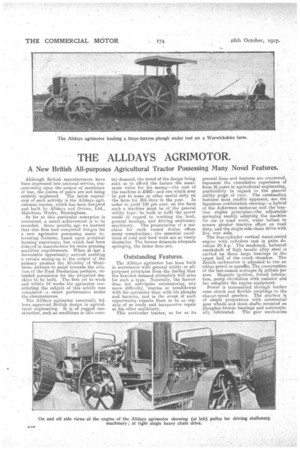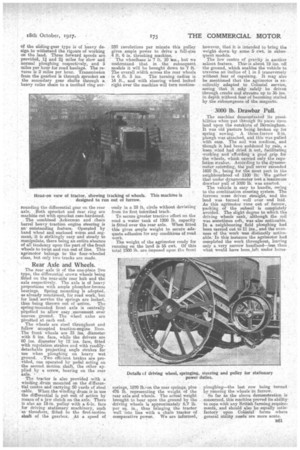THE ALLDAYS AGRIMOTOR.
Page 20

Page 21

If you've noticed an error in this article please click here to report it so we can fix it.
A New British Ail-purposes Agricultural Tractor Possessing Many Novel Features.
Although British manufacturers have been impressed into national service, concentrating upon the output of munitions of war, the claims Df peace are not being entirely neglected. The latest expression of such activity is the Alklays agricultural tractor, which has been designed and built by Alldays and Onions, Ltd., Matchless Works, Birmingham.
So far as this particular enterprise is concerned, a smart achievement is to,be recorded. Some months ago we learned that this firm had completed designs for a new agrimotor possessing many interesting features, based upon practical farming experience, but which had been delayed in manufacture for more pressing munition requirements. When at last a favourable opportunity arrived enabling a certain easing-up in the output of the primary product the Ministry of Munitions, anxious to assist towards the solution of the Food Production problem, extended permission for the projected machine to be built. The firm set to work and within 14 weeks the agrimotor constituting the subject of this article was completed—a smart performance under the circumstances.
The Alldays agrimotor essentially follows approved British design in agricultural engineering. It is of Tugged construetion, such as conditions in this catm try demand, the trend of the design being such as to afford the farmer the maximum value -for his snoney—the cost of the machine is £485—and one which may be put to home or other useful duty on the farm for 365 days in the year. In order to yield 100 per cent, on the farm such a machine must be of the general utility type: be built to full the power needs in regard to working the land, general haulage and driving stationary machinery. The presentation of a machine for such varied duties offers many complexities : the essential conditions of road and land work are so vastly dissimilar. The former demands adequate springing, the latter does not.
Outstanding Features.
The Alldays agrimotor has been built in accordance with general utility or allpurposes principles from the feeling that the heaviest demand ultimately will arise for such a type. Naturally, the farmer does, not anticipate encountering any more difficulty, worries or breakdowns • with his agrimotor than with his ploughe and harrows, and in the event of such supervening expects them to be as capable of as ready and inexpensive repair as his other machinery.
This particular tractor, so far as its general lines and features are concerned, represent the cumulative experience of from 16 years in agricultural engineering, particularly in regard to the general utility point of view. The outstanding features most readily apparent, are the • ingenious combination steering--a hybrid of theAckerman motorcar and the traction engine principles—the adjustable springing readily adapting the machine for car or road work, water ballast to ensure freater tractive effort on road duty, and the single-side chain drive with live rear axle.
The four-cylinder vertical water-cooled engine with cylinders cast in pairs develops 30 h.p. The machined, balanced crankshaft of high `tensile alloy steel is carried on three large bearings in the upper half of this crank chamber. The Zenith carburetter is adjusted to run on either petrol or paraffin. The coosnmption of the last-named averages 2i gallons per acre. Magneto ignition, forced lubrication, pump circulation with radiator and fan complete the engine equipment. Power is transmitted through leather cone clutch and flexible couplings to the change-speed gearbox. The gearbox is of ample proportions with substantial gear wheels and stout shafts mounted on phosphor-bronze bearings and automatic
ally lubricated. The gear mechanism
of the sliding-gear type is of heavy design. to withstand the rigours of working on the land. Three forward speeds are provided, 1 and 21 miles for slow and normal ploughing respectively, and 5 miles per hour for road haulage. The reverse is 2 miles per hour. Transmission from the gearbox is through sprocket on the secondary gear shafts through a heavy roller chain to a toothed ring sur rounding the differential gear on the rear axle. Both sprocket and rear ring are machine cut with sprocket case-hardened.
The combined Ackerman and chain barrel heavy traction engine steering is anoutstanding feature. Operated by hand wheel and enclosed worm and segment, it is strikingly easy and steady to manipulate, there being an entire absence of all tendency upon the part of the front wheels to twist and run out of line. This agrimotor belongs to the four-wheeled class, but only two tracks are made.
Rear Axle and Wheels.
The rear axle is of the one-piece line type, the differential crown wheels being fitted on the near-side rear hub and the axle respectively. The axle is of heavy proportions with ample phosphor-bronze bearings. Spring mounting is adopted, as already mentioned, for road work, but for land service the springs aro locked, thus being thrown out of action. The spring-mounted front axle is centrally pissotted to allow easy ,movement over uneven ground. The wheel axles are pivotted at each end. .
The wheels are steel throughout and follow accepted traction-engine lines. The front wheels are 33 ins, diameter with 6 ins. face, while the drivers are 60 ins. diameter by 12 ins, face, fitted with regulation strikes and with readilydetachable projecting angle strakes for use when ploughing on heavy wet ground. Two efficient brakes are provided, one operated by pedal acting on the second motion shaft, the other applied by a screw, bearing on the rear axle. ^ The tractor is also provided with a winding drum mounted on the differential centre and carrying 50 yards of steel cable. When the winding drum is in use the differential is put out of action by means of a jaw clutch on the axle. There is also an 18-in, pulley with a 6-in, face for driving stationary machinery, such 'as thresher; fitted• to the first-motion shaft of the gearbox. At a speed of
250 revolutions per minute this pulley gives ample power to drive a full-size 4 ft. 6 in. threshing machine.
The wheelbase is 7 ft, 10 'ins., but we understand that in the subsequent. models it will be brought down to 7 ft. The overall width across the rear wheels
is 6 ft. 3 ins. The turning radius is 34 ft., and with steering wheel locked right over the machine will turn continn onsly in a 28 ft. circle without deviating from its first inicribed track.
To secure greater tractive effort on the road a water tank of 1200 lb. capacity is fitted over the rear axle. When fitted this gives ample weight to secure adequate adhesion for any conditions of road work.
The weight of the agrimotor ready for running on the land Is 55 owl. Of this total 1500 lb. are imposed open the front
springs, 1870 lb.kon the rear springs, plus 476 lb. representing the weight of the rear axle and wheels. The actual weight brought to bear upon the ground by the driving wheels is approximately 6.7 lb. per sq. in., thus bringing the tractor well into line with a chain tractor of comparative power. We are informed, however, that it is intended to bring the weight down by some 5 cwt. in subsequent models.
The low centre of gravity is another salient feature. Tlaitris about 19 ins, off the ground, which enables the vehicle to traverse an incline of 1 in 5 transversely without fear of capsizing. It may also .
be mentioned that the agrimotor excellently adapted. te Colonial service, seeing that it my safely be driven through creeks and streams up to 36 ins. in depth without fear of becoming stalled by the submergence of the magneto.
3000 lb. Drawbar Pull.
The machine demonstrated its possibilities when pit throtigh its paces upon land upon the outskirts of Birmingham. It was old 'pasture being broken up for spring sowing. A three-furrow
plough was attached; and this was pulled with ease. The soil was medium and though it had been soddenecl by rain, keen wind had dried it out, facilitating working and affording a good grip for the wheels, which carried only the regulation stra,kes. Amending to the dynamometer recording, the pull never exceeded 1600 lb., being for the most part in the neighbourhood of 1100 lb: We gather that under dynamometer test a maximum drawbar pull of 3000 lb. was exerted.
The vehicle is easy to handle, owing to the combination steering system. The furrows were driven straight, and the land was turned well over and laid. As this agrimotor rims out of furrow, packing of the subsoil is completely avoided. The slight degree to which the driving wheels sank, although the soil was sometimes soft, was also noticeable. In a. neighbouring field ploughing had been carried out to 11 ins., and the evenness of the work was distinctly noticeable: In this instance the agrimotor had completed the work throughout, leaving only a .very narrow headland—less than what would have been, left under horse ploughing—the last row being turned by running the wheels in furrow.
So far as the above demonstration is concerned, this machine proved its ability to cope with any British farming _requirements, and should also be equally satisfactory upon Colonial farms where general utility Deeds are more acute.
























